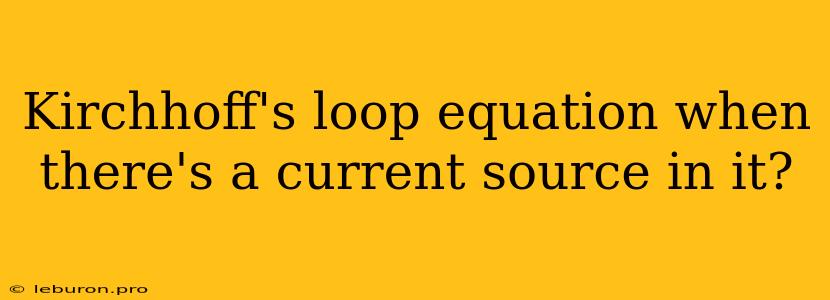Kirchhoff's Voltage Law (KVL) is a fundamental principle in circuit analysis, stating that the algebraic sum of all voltages around any closed loop in a circuit must equal zero. This law is widely used to analyze circuits with various components, including resistors, capacitors, inductors, and even current sources. However, applying KVL when a current source is present in the loop can be a bit trickier. This article will delve into the intricacies of dealing with current sources within KVL and explore the strategies for effectively applying Kirchhoff's loop equation in such scenarios.
Understanding the Challenges
Current sources, unlike voltage sources, impose a specific current flow regardless of the voltage across them. This behavior can disrupt the straightforward application of KVL, which primarily focuses on voltage drops across components. The presence of a current source introduces an unknown voltage across it, complicating the voltage summation process.
Strategies for Handling Current Sources
To effectively apply KVL in the presence of a current source, we need to employ a few key strategies:
1. Defining Loop Direction and Current Flow
Firstly, we must choose a direction for traversing the loop, which is arbitrary but consistent throughout the analysis. Secondly, we need to define the current flow direction for each branch of the loop, taking into account the imposed current from the source.
2. Applying KVL with Current Source Constraints
When applying KVL, we must treat the current source as a constraint, meaning we cannot simply assign a voltage drop across it. Instead, we incorporate the known current value into our equations, acknowledging that the current through the current source remains fixed.
3. Using Superposition or Node Voltage Analysis
For more complex circuits, it might be beneficial to use superposition or node voltage analysis to simplify the problem. Superposition allows us to analyze the circuit by considering the effect of each source individually and then combining the results. Node voltage analysis focuses on finding the voltage at key nodes in the circuit, which can then be used to determine current and voltage across other components, including the current source.
Illustrative Example
Let's consider a simple circuit with a current source, a resistor, and a voltage source.
!
The current source imposes a current I_S flowing from left to right. We want to determine the voltage across the resistor R.
Applying KVL:
We choose a loop direction clockwise. Applying KVL, we start from the negative terminal of the voltage source:
- -V_S (voltage drop across voltage source)
- +I_S * R (voltage drop across resistor, note that the current direction is in the same direction as the loop direction)
Setting the sum equal to zero:
-V_S + I_S * R = 0
Solving for the voltage across the resistor:
V_R = V_S - I_S * R
This equation demonstrates how the voltage across the resistor is influenced by both the voltage source and the current source.
Conclusion
Kirchhoff's loop equation, while a powerful tool for circuit analysis, requires careful consideration when dealing with current sources. Understanding the constraints imposed by current sources and employing suitable strategies, such as treating them as current constraints or using superposition/node voltage analysis, allows us to effectively apply KVL even in the presence of these unique elements. By mastering the nuances of working with current sources, we can gain a deeper understanding of circuit behavior and effectively analyze a wide range of electrical networks.
Remember that applying KVL with current sources requires a clear understanding of the current direction and voltage drops. Careful analysis and a systematic approach will ensure accurate results and provide valuable insights into the workings of circuits with current sources.
